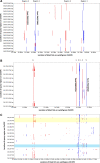Quantitative trait locus mapping combined with variant and transcriptome analyses identifies a cluster of gene candidates underlying the variation in leaf wax between upland and lowland switchgrass ecotypes
- PMID: 33760937
- PMCID: PMC8263549
- DOI: 10.1007/s00122-021-03798-y
Quantitative trait locus mapping combined with variant and transcriptome analyses identifies a cluster of gene candidates underlying the variation in leaf wax between upland and lowland switchgrass ecotypes
Abstract
Mapping combined with expression and variant analyses in switchgrass, a crop with complex genetics, identified a cluster of candidate genes for leaf wax in a fast-evolving region of chromosome 7K. Switchgrass (Panicum virgatum L.) is a promising warm-season candidate energy crop. It occurs in two ecotypes, upland and lowland, which vary in a number of phenotypic traits, including leaf glaucousness. To initiate trait mapping, two F2 mapping populations were developed by crossing two different F1 sibs derived from a cross between the tetraploid lowland genotype AP13 and the tetraploid upland genotype VS16, and high-density linkage maps were generated. Quantitative trait locus (QTL) analyses of visually scored leaf glaucousness and of hydrophobicity of the abaxial leaf surface measured using a drop shape analyzer identified highly significant colocalizing QTL on chromosome 7K (Chr07K). Using a multipronged approach, we identified a cluster of genes including Pavir.7KG077009, which encodes a Type III polyketide synthase-like protein, and Pavir.7KG013754 and Pavir.7KG030500, two highly similar genes that encode putative acyl-acyl carrier protein (ACP) thioesterases, as strong candidates underlying the QTL. The lack of homoeologs for any of the three genes on Chr07N, the relatively low level of identity with other switchgrass KCS proteins and thioesterases, as well as the organization of the surrounding region suggest that Pavir.7KG077009 and Pavir.7KG013754/Pavir.7KG030500 were duplicated into a fast-evolving chromosome region, which led to their neofunctionalization. Furthermore, sequence analyses showed all three genes to be absent in the two upland compared to the two lowland accessions analyzed. This study provides an example of and practical guide for trait mapping and candidate gene identification in a complex genetic system by combining QTL mapping, transcriptomics and variant analysis.
Conflict of interest statement
The authors have no conflicts of interest or competing interests.
Figures





Similar articles
-
Environmentally responsive QTL controlling surface wax load in switchgrass.Theor Appl Genet. 2020 Nov;133(11):3119-3137. doi: 10.1007/s00122-020-03659-0. Epub 2020 Aug 14. Theor Appl Genet. 2020. PMID: 32803378
-
Comparative transcriptome profiling of upland (VS16) and lowland (AP13) ecotypes of switchgrass.Plant Cell Rep. 2017 Jan;36(1):129-150. doi: 10.1007/s00299-016-2065-0. Epub 2016 Nov 3. Plant Cell Rep. 2017. PMID: 27812750 Free PMC article.
-
Transcriptome analysis in switchgrass discloses ecotype difference in photosynthetic efficiency.BMC Genomics. 2016 Dec 16;17(1):1040. doi: 10.1186/s12864-016-3377-8. BMC Genomics. 2016. PMID: 27986076 Free PMC article.
-
QTL mapping of winter dormancy and associated traits in two switchgrass pseudo-F1 populations: lowland x lowland and lowland x upland.BMC Plant Biol. 2020 Nov 30;20(1):537. doi: 10.1186/s12870-020-02714-8. BMC Plant Biol. 2020. PMID: 33256587 Free PMC article.
-
Natural variation in genes potentially involved in plant architecture and adaptation in switchgrass (Panicum virgatum L.).BMC Evol Biol. 2018 Jun 14;18(1):91. doi: 10.1186/s12862-018-1193-2. BMC Evol Biol. 2018. PMID: 29898656 Free PMC article.
Cited by
-
Finger millet: a hero in the making to combat food insecurity.Theor Appl Genet. 2024 May 21;137(6):139. doi: 10.1007/s00122-024-04637-6. Theor Appl Genet. 2024. PMID: 38771345 Free PMC article. Review.
-
Genome-wide association study and genetic mapping of BhWAX conferring mature fruit cuticular wax in wax gourd.BMC Plant Biol. 2022 Nov 19;22(1):539. doi: 10.1186/s12870-022-03931-z. BMC Plant Biol. 2022. PMID: 36401157 Free PMC article.
-
Virulence and Genetic Diversity of Puccinia spp., Causal Agents of Rust on Switchgrass (Panicum virgatum L.) in the USA.Pathogens. 2025 Feb 14;14(2):194. doi: 10.3390/pathogens14020194. Pathogens. 2025. PMID: 40005569 Free PMC article.
-
Genome analyses reveal population structure and a purple stigma color gene candidate in finger millet.Nat Commun. 2023 Jun 21;14(1):3694. doi: 10.1038/s41467-023-38915-6. Nat Commun. 2023. PMID: 37344528 Free PMC article.
-
Genotyping-by-Sequencing and QTL Mapping of Biomass Yield in Two Switchgrass F1 Populations (Lowland x Coastal and Coastal x Upland).Front Plant Sci. 2022 May 19;13:739133. doi: 10.3389/fpls.2022.739133. eCollection 2022. Front Plant Sci. 2022. PMID: 35665173 Free PMC article.
References
-
- Ali S, Serba DD, Jenkins J, Kwon S, Schmutz J, Saha MC. High-density linkage map reveals QTL underlying growth traits in AP13xVS16 biparental population of switchgrass. Glob Chang Biol Bioenergy. 2019;11:672–690.
-
- Bragg J, Tomasi P, Zhang L, Williams T, Wood D, Lovell JT, Healey A, Schmutz J, Bonnette JE, Cheng P, Chanbusarakum L, Juenger T, Tobias CM. Environmentally responsive QTL controlling surface wax load in switchgrass. Theor Appl Genet. 2020;133:3119–3137. - PubMed
-
- Brunken JN, Estes JR. Cytological and morphological variation in Panicum virgatum L. Southwest Nat. 1975;19:379–385.
MeSH terms
Substances
Grants and funding
- DE-SC0010743/U.S. Department of Energy, Office of Science, Office of Biological and Environmental Research
- DE-AC05-000R22725/The Center for Bioenergy Innovation, a United States Department of Energy Research Center supported by the Office of Biological and Environmental Research in the DOE Office of Science
LinkOut - more resources
Full Text Sources
Other Literature Sources
Miscellaneous

